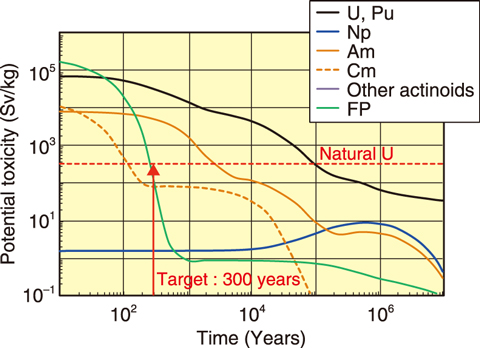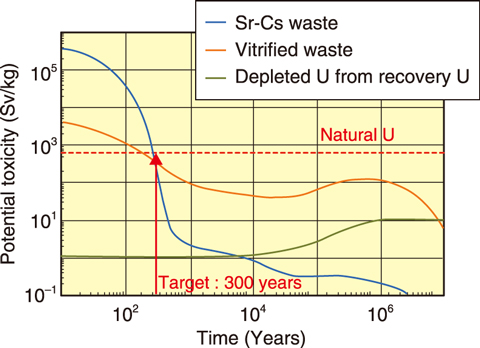
Fig.6-2 Potential toxicity in spent fuel of a Light Water Reactor (LWR)

Fig.6-3 Overview of proposed nuclear fuel cycle

Fig.6-4 Potential toxicity of waste generated from proposed nuclear fuel cycle
The safety of waste disposal during nuclear power generation must be ensured by limiting public dose. Furthermore, the potential toxicity must be reduced for public acceptance. The potential toxicity has been defined as the dose when all radionuclides present in waste are ingested orally; the target value is less than the dose of natural uranium (U) required to fabricate nuclear fuel; i.e., the aim is to ensure that the radioactive toxicity of waste is below that present in nature.
The radioactive toxicity of nuclear fuel increases when used for power generation and then decreases due to the decay of nuclides. However, approximately one hundred thousand and three thousand years are required for plutonium (Pu) and americium of Minor Actinides (MA: Np, Am, Cm), respectively, to reduce naturally and become less than the dose of natural U (Fig.6-2). Thus, this timeline must be reduced.
A fast reactor and Accelerator-Driven transmutation System (ADS) have been developed to realize a cooling time of 300 years. This work aims to shorten the cooling time using an High Temperature Gas-cooled Reactor (HTGR), which is a thermal neutron reactor. Generally, it has been thought that the shortening of the cooling time by transmutation of MA was only possible using the fast reactor system including ADS. By finding the characteristics that TRU is less likely to accumulate in thermal neutron reactors, it is confirmed that the possibility to realize multiple recycling of TRans Uranium elements (TRU: Pu and MA) similar to fast reactor systems by core designing and fuel cycle mass balance evaluation. This represents the first documented study involving a thermal neutron reactor to establish the concept of confining a long-lasting reduction of TRU nuclides in a fuel cycle consisting of use for power generation and reprocessing (Fig.6-3). In addition, the thermal neutron reactor system’s negative reactivity coefficient, large delayed neutron fraction, and high heat removal performance due to graphite structural materials in the loss of coolant accident can be utilized to take advantage of the HTGR’s inherent safety features.
The potential toxicity of wastes, including Sr-Cs, vitrified, and degraded U wastes, were reduced within 300 years by evaluation of radioactive nuclear dose, as shown in Fig.6-4. In the evaluation of the footprint of disposal repository, that is compared with the that of the representative reprocessing scenario based on LWR waste disposal in order to confirm the effect of waste volume reduction. That is reduced to 1/300 compared with the representative one. Thus, it has been shown that an HTGR can be used to achieve the same cooling time as fast reactors and ADSs. Future work will focus on evaluating the economics of the proposed nuclear fuel cycle.
<Previous: 6 HTGR Hydrogen and Heat Application Research | Next: 6-2>